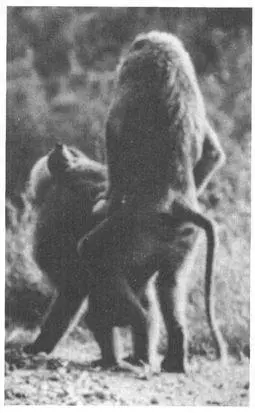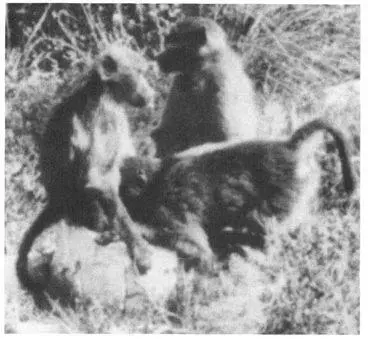Mounting between two male Savanna Baboons in Tanzania

In Savanna Baboons, homosexual mounting occurs in a variety of contexts, including during good-natured play-fighting. However, in this species (and to some extent also in the other species) same-sex mounting is most prominent as part of a unique form of male “greeting” interaction. Whenever two males meet each other, they exchange a series of ritualized sexual behaviors that may include homosexual mounting and invitations to mount, as well as a wide variety of other sexual and affectionate contacts. One such behavior is known as DIDDLING, in which the males fondle each other’s genitals, including touching or pulling on the penis and fondling the scrotum. Males also embrace and kiss each other on the head or mouth, and may even bend down to kiss, lick, or nibble on another male’s penis or nuzzle his groin and thighs. Sometimes a male will also nuzzle another male’s back with his nose, especially during a mount. Another “greeting” behavior involves one male patting, grabbing, and sometimes even nuzzling or fingering another male’s rear end. Although most “greeting” interactions are relatively brief and one-sided, occasionally two males develop a closer, bonded relationship sometimes known as a COALITION, in which the “greeting” interactions are more extensive, frequent, and reciprocated. Partners in such an alliance take turns exchanging sexual behaviors with each other (especially diddling), and they often protect and help one another. Such coalitions between males may become stable, long-lasting associations that persist for many years.
A male Savanna Baboon in southern Africa nuzzling the genitals of another male

Several different kinds of intersexual or hermaphrodite individuals occur spontaneously in Savanna Baboons. In South African populations, gender-mixing individuals sometimes become high-ranking and powerful members of their troops. Such animals have female genitalia and internal organs, yet their mammary glands are not developed. Genetically, they are male (having XY chromosomes), physically they are large—exceeding the proportions of nonintersexed females and sometimes even males—and sexually, they often interact with males. Another type of intersexuality found in Baboons involves animals that have male external genitals (including testes) combined with some female internal reproductive organs (such as a uterus and fallopian tubes).
Frequency: Among Savanna Baboons, homosexual activity is common: 13—24 percent of all mounting behavior is between males and up to 9 percent is between females. “Greetings” interactions—which include ritualized homosexual activities—occur more than twice as often as any other form of interaction between males and take place roughly once every 50 minutes in some troops. Approximately 10 percent of males in some areas develop closely bonded coalitions, which comprise about 2 percent of all dyads between males. In Hamadryas Baboons, sexual behavior (homosexual or heterosexual) is overall less frequent, but approximately one-third to two-thirds of sexual activity may occur between animals of the same sex (mostly between males). In a study of wild Geladas, homosexual interactions between males were observed about once every two hours; in captivity, 14—25 percent of mounts are between males and 2—3 percent are between females.
Orientation: In Savanna Baboons, the entire male population participates in homosexual “greetings” interactions; all adult males (including those in bonded coalitions with other males) are sexually active with females as well, indicating a high degree of bisexuality. This is probably true to a lesser extent for females, not all of whom engage in homosexual mounting. In Hamadryas Baboons, harem-holding males may be bisexual, mounting both males and females, while Gelada harem males are usually exclusively heterosexual (although they may engage in same-sex genital handling if there is another male in the troop). Some “bachelor” males in both species may engage solely in homosexual activity, especially adolescents and younger adults. In Geladas, for example, an average of 12 percent of the population lives in all-male groups (where same-sex activity usually occurs). In some areas this proportion is as high as 40 percent or more, although most such males do eventually breed.
Nonreproductive and Alternative Heterosexualities
A large proportion of Baboon heterosexual behavior involves nonprocreative activities. Savanna and Hamadryas Baboons commonly mate when the female cannot get pregnant. In some Savanna populations, up to 18 percent of heterosexual copulations occur during the nonfertilizable stages of her ovulatory cycle (including during menstruation) and 2—12 percent of matings happen when the female is already pregnant. Most females, however, remain abstinent while pregnant or lactating and in fact are (hetero)sexually active for less than 10 percent of their adult lives. Heterosexual mountings do not always involve penetration and/or ejaculation, either—in fact, one study found that less than 40 percent of opposite-sex matings in Savanna Baboons involved “full” copulation. Moreover, a variety of sexual behaviors besides vaginal intercourse occur, including fondling of genitals and females mounting males (REVERSE mounts). Masturbation is also a component of Baboon sexual expression, with several innovative techniques employed: Savanna males stimulate the penis with their hand, lick their own penis, rub their genitals against the ground, or stroke the penis with the tip of the tail, while females stimulate the clitoris and perineal area with the tail or fingers. Both males and females show evidence of sexual arousal during grooming, in the form of rhythmic erection of the genitals—“penis flicking” in males, and labial and clitoral swelling and “pulsation” in females. Sexual activity in Baboons also sometimes includes copulation with partners that are not optimal for breeding: adult male Savanna Baboons and adult female Hamadryas Baboons may mate with juvenile animals, incestuous matings are common in inbred troops, while “friendships” and sexual behavior between Baboons and Common Chimpanzees have been observed in the wild (and between female Savanna Baboons and male Macaques in captivity). In addition, infertile females are occasionally found in Savanna Baboons—in one troop they constituted 10 percent of all the adult females—and these individuals continue to engage in sexual behavior.
Several other forms of nonbreeding are found among Baboons. Geladas and Hamadryas Baboons, for example, have significant “bachelor” populations that do not generally participate in reproduction (constituting 20 percent of the male Hamadryas population). Older female Savanna Baboons sometimes experience a postreproductive period, while breeding-age males and females in this species often form platonic “friendships” with each other. Sexual relations in Baboons, however, are sometimes characterized by significant antagonism and even violence between the sexes. Hamadryas harem males often threaten and attack females, biting them on the neck to prevent them from leaving the group. Adult male Savanna Baboons sometimes rape younger females, often seriously injuring them, and adult females avoid or refuse a third of all mating attempts by males. In some populations, abortions and infanticide result when an outside male takes over a troop. He viciously attacks both mothers and infants to maximize his breeding opportunities; as a result of this brutality, females may suffer severe injuries as well as miscarriages, and infants may be killed. There is also evidence that females attack other females in order to suppress their reproduction. Infanticide was recently discovered among Geladas as well. Many male Baboons act as “baby-sitters” for infants, although occasionally the youngsters become injured during fights between their “baby-sitter” (or “kidnapper”) and other males.
Читать дальше














